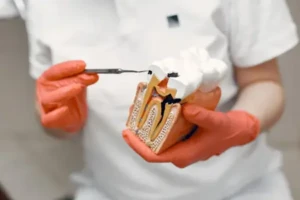Root Canal Treatment: Everything You Need to Know
Published: 03 September 2025
At Clyde Munro, we know that visiting the dentist can be a nerve-wracking experience for some patients. Some may have had a negative experience in the past, while others may be worried about potential pain and recovery time.
When it comes to fears of specific procedures, one of the most common among patients is the fear of root canal treatment. Synonymous with being an uncomfortable experience usually via annecdotes, at Clyde Munro, we believe that this important treatment is one of the most misunderstood among the general public.
To help our patients feel more comfortable and secure during this procedure, we will cover everything you need to know about root canal treatment, from the reasons for the treatment to the procedure and recovery process.
What is the root canal?
Before examining the details of root canal treatment, it’s essential that we first understand the function of the treatment and what it’s designed to do.
Simply put, the root is the part of the tooth that anchors it to the jawbone, holding it in place so we can bite and chew food. Within each root, there is a bundle of nerves and blood vessels, known as the pulp. The chamber in which this pulp is contained is called the pulp chamber and this extends into each root and is called the root canal.
What is the purpose of root canal treatment?
Root canal treatment is necessary when the pulp in the pulp chamber or root canal have become compromised.
When the pulp chamber or root canal is insulted or damaged, it can lead to infection and inflammation of the pulp. This can be very painful, and if left untreated, may require the removal of the tooth, which, apart from the cost of extraction, will also involve the expense of a suitable replacement. Occasionally a pulp can become infected without any pain whatsoever but there will be other signs.

Reasons why root canal treatment is required
Now that we understand why root canal treatment is necessary, we can examine the circumstances that can precipitate the type of damage that may require root canal treatment.
Tooth decay
Root canal treatment may be necessary due to severe tooth decay, which is caused by acid produced by a buildup of bacteria in the mouth. When the decay reaches the tooth’s pulp, it results in inflammation and infection.
Physical trauma
Physical damage to a tooth may lead to a crack or fracture, exposing the root and pulp, and significantly increasing the likelihood of infection.
Gum disease
Although gum disease doesn’t directly cause root canal infections, it can lead to gum recession, which exposes the root and increases its vulnerability to infection, ultimately leading to an insult to the pulp.
Damaged dental treatments
Just as with a regular tooth, if a crown or dental bridge is damaged and the real tooth becomes exposed, this can lead to the pulp being exposed and prone to infection.
How common is root canal treatment?
While for many, root canal treatment can be a daunting procedure and one that most would prefer to avoid, the truth is that a third of all adults in the UK report to having undergone this procedure at least once in their lives.
Do root canal treatments hurt?
Although root canal treatments are often feared by patients, the numbing agents used by dentists during the procedure help ensure that patients are unlikely to feel any pain at all. There are a variety of measures to ensure the procedure is not painful.
However, as with any surgical operation, tenderness is normal, and the affected area should be treated with extra care during this time.
The root canal treatment process
Now that we have a better understanding of some of the most common questions surrounding root canal treatments, let’s examine the procedure itself:
Preparing the tooth for root canal treatment
First, the dentist will initiate the process by numbing the tooth in question, to prevent unnecessary discomfort.
Due to this being a localised anaesthetic, the patient generally remains awake for root canal treatment; however, in cases where a patient suffers from severe dental anxiety, sedation may be the preferred option.
Protecting the rest of the mouth
The dentist will then insert what is known as a ‘dental dam’ onto the tooth in the mouth.
A bit like a poncho for the rest of the mouth, the dam ensures that only the tooth being treated is exposed, reducing the potential for infection to spread.
Treating the tooth
Next, the dentist will remove the damaged tooth material in the tooth to carefully remove the infected pulp, before flushing out the canal to remove the infected tissue.
The root canals are then reshaped using small instruments to remove any further infected material and is sealed with a temporary filling, which usually includes an antimicrobial dressing.
Completing the treatment
Once the tooth has settled completely, the patient will be invited to return to the practice so their canal can be sealed with a permanent filling. Patients can expect a period of one to two weeks between appointments; however, this timeframe will mainly depend on the individual circumstances of the patient.
This procedure can sometimes be completed in one visit.
Following this permanent root canal filling , a crown may be needed to ensure the tooth’s structural integrity remains.
Recovering from root canal treatment
After the initial surgery, patients may experience some numbness for a few hours and facial tenderness and slight swelling in the days that follow. These symptoms can sometimes occur after a root canal treatment and should not be a cause for concern.
However, if swelling persists or becomes excessively painful, be sure to contact your dental practice immediately.

How to get root canal treatment
If you think that you need root canal treatment, it is best to contact your dentist as soon as possible to minimise further discomfort.
Find your practice on our website or contact our team to learn more about root canal treatment and other available procedures.





